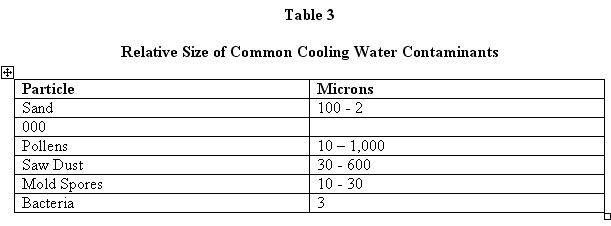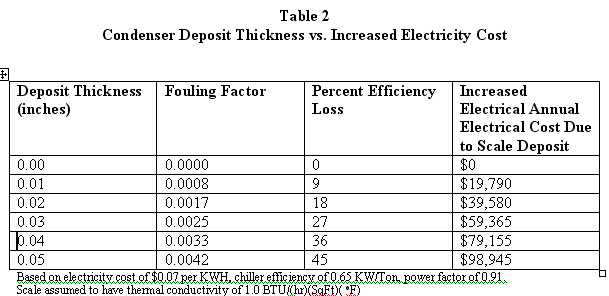by Michael McDonald — For commercial buildings, the HVAC system represents a major capital investment and is generally the largest consumer of electricity. Effective maintenance is required to maximize the service life of the HVAC system and keep operating costs low. The water treatment program is a critical part of the overall preventive maintenance program. Although filtration is often overlooked in the maintenance equation, it is an important adjunct to the water treatment program for both cooling towers and closed loops and provides many benefits.
The most obvious benefit of filtration is aesthetic. A filter removes visible suspended and settled solids giving the water a clearer and cleaner appearance. Of greater economic benefit, though not as visible, is the effect cleaner water has on the water treatment program. Beyond general aesthetics, filters provide cost-saving benefits such as:
- Improved heat transfer due to reduced deposition and fouling
- Reduced potential for under-deposit corrosion
- Improved biological control
- Improved chemical performance
- Less mechanical wear
In a typical office building, approximately 60% of total utility cost is spent operating the HVAC system. Water treatment products and services are a very small fraction of the total utilities bill. In fact, most water treatment programs cost less than the water and sewer costs. The main energy consumers in a water-cooled air conditioning system are the chiller, recirculating pumps, tower fans and air handler fans. Deposition (fouling) on heat exchange surfaces reduces transfer and results in higher energy costs. Some deposits are more insulating than others and thus have a greater impact on energy requirements. For example, calcium carbonate scale deposits transfer heat over four times better than biofilm deposits (bacterial slime). As a result, slime increases head pressure and energy requirements and will shut down a chiller much faster than normal scale. An effective filter greatly reduces the tendency for deposits and fouling and makes it easier to control microbiological growth.
|
|
The following table shows the potential economic impact of deposits on a 500-ton chiller load running 24 hours a day. Actual increased energy use depends on compressor type, efficiency rating, actual operating head pressure and percent operating load.
|
|
For the same thickness, the increased cost associated with a biofilm deposit can be significantly greater than with scale, depending on the actual scale composition. It becomes clear that good microbiological control is vital for efficient operation. Coupled with a proper water treatment program, effective filtration reduces adverse effects of deposits, fouling and microbiological growth simultaneously. When looking at the total cost of operation of your HVAC system, even an expensive filter system can have significant payback in terms of improved results and lower operating costs.
Suspended Solids
Suspended solids are present in both open and closed recirculating water systems. They tend to settle in piping in areas of low elevation and areas of low flow, such as a cooling tower basin. This provides a place for bacteria to attach and grow and increases the potential for under-deposit corrosion and microbiologically induced corrosion (MIC). Free-moving solids can be abrasive and cause excessive wear of pump seals and valves. Under high velocity conditions, solids can cause erosion of system piping, particularly with soft metals, such as copper. Suspended solids also increases the potential for fouling key water flow passages, such as those on the hot deck of a cooling tower or the channels in plate and frame heat exchangers.
The physical properties of size, shape, hardness and malleability of particulate matter contribute to the types of problems that may be experienced and determine the type of filter selected. Most filters placed in HVAC systems are designed to remove particles smaller than the human eye can detect, which is about 40 microns. Singly, particles less than 40 microns are undetectable to most viewers, but collectively they can produce effects that are visible, such as discoloration or cloudiness, which is known as turbidity. The higher the level of suspended solids in a water sample, the greater the turbidity.
|
|
There are many types of filters available, with granular media filters (sand), bag filters and cartridge filters being most common. The following factors should be considered when choosing a filter:
- Type of application open or closed recirculating systems
- Total system volume
- Flow rate
- Pressure requirements
- Particle size
- Total solids loading
- Available maintenance staff
A side stream filter for a cooling tower or closed loop should typically filter 3% to 5% of the total flow. As flow rate increases, so does the cost of the filter necessary to accommodate it. Large volume systems, such as thermal storage systems, may contain 100,000 gallons of water or more. For these very large systems it is common practice to filter the total system volume at least once every 24 hours.
It is important to consider the relationship between flow and pressure when selecting and sizing a filter. In HVAC applications, the filters primarily used function by providing some form of barrier between the solution and the particle to be removed. That barrier may be a screen, fabric, paper, woven bag of a given mesh size or some form of granular media. As particles become trapped in the filter, the spaces through which water flows become blocked and the flow is reduced. The particle size and total solids loading determines how quickly and how frequently a given filter will need cleaning to remain functional. Flow can be reduced to the point that the filter can no longer do its job effectively or, in extreme cases, starve a system for flow. To maintain a given flow rate through a fouled filter using a recirculating pump, the pump must work harder, increasing the power requirements of the pump. The need for available maintenance personnel to change media becomes apparent when considering the effect that neglect can have on efficiency, operating cost and performance.
Cooling Tower Filtration
Cooling towers do a good job of both transferring heat from a building to the atmosphere and scrubbing the air that is pulled through them. The evaporative cooling process concentrates dissolved and suspended solids entering the system through makeup water and fan intake. Depending on the activities occurring in the vicinity of the cooling tower, or the season of the year, the air drawn through the tower can introduce all types of airborne contaminants from leaves and pollen to construction debris. The contaminants promote both deposit formation and fouling. As the total solids loading on the cooling tower increases, so does the potential for problems.
Suspended solids also interfere with the water treatment program by adsorbing key scale/corrosion inhibitors, dispersants and biocides. They can greatly increase the amount of chemical required for effective control. Also, corrosion inhibitors cannot protect metal surfaces that are shielded by settled silt or sludge. Since biocides cannot penetrate through suspended solids, microbiological growth can quickly rebound after a biocide application. The presence of suspended solids can greatly compromise the effectiveness of a water treatment program and dramatically increase the costs.
To combat suspended solids, some cooling towers are equipped with a sand filter. Typically, these are piped in a side steam arrangement. Particles as small as 10 microns can be removed by a properly functioning sand filter. While this type of filter does a good job filtering the water, particulates can settle in the sump or basin causing silt and sludge to build up in these areas. This creates challenging water treatment problems, such as under-deposit corrosion and increased microbiological activity.
Sweeper jet systems are an add-on to your filter system that can make the problem of settled solids more manageable. The nozzles or jets are designed so the discharge flow is increased by a venturi effect. A venturi type nozzle effectively boosts a one gpm (gallons per minute) inlet flow rate to a five gpm discharge flow rate through the nozzle. These jets or nozzles lift the settled solids from the basin or sump surface and direct them to the filter pump intake where they can be removed by the filter, thus promoting a healthy water treatment program.
Closed Loop Filtration
Closed systems benefit more from filtration than one would expect. By definition, a true closed system should be somewhat immune to contamination since it is isolated. In reality, systems can be compromised before a new building has its first tenant. Most closed system problems resulting in visibly dirty water can be traced back to initial installation and result from poorly performed or lack of preoperational cleaning and passivation.
When installed on systems already visibly dirty, a self-cleaning, high-performance granular media filter (HPF) offers several advantages over traditional bag or cartridge filters. One is that the human element is eliminated. The filter automatically backwashes based on differential pressure and self cleans with fresh water rather than system water. This high-performance media is similar to sand, but has smaller granules and a large surface area. This allows particulate matter to penetrate deeply into the filter bed, but still be easily released on backwash. It removes much smaller suspended matter than conventional sand filters, while operating at higher flow rates and with longer times between backwashes. Furthermore, there are no bags or cartridges to change. While a bag or cartridge can remove smaller particles, the HPF can remove particles down to five microns in size. An immediate savings in the cost of bags or cartridges and the manpower to change them can be realized by the consumer when using the HPF. Another advantage is they provide measurable results quickly. In one case study of a 25,000 gallon closed loop, total iron was reduced from 57 ppm (parts per million) to 2.7 ppm in three months and turbidity was reduced from 368 NTU to 3 NTU.
As a facility engineer or property manager, you can be faced with a variety of waterside problems that will reduce the life and efficiency of your HVAC systems. A professional water treatment company can help you cost-effectively manage those issues.
Michael McDonald is corporate engineer for Chem-Aqua. This article appeared in the March/April 2009 edition of Facilities Engineering Journal, published by AFE, the Association for Facilities Engineering (www.AFE.org). Note: AFE content is offered for the personal, individual non-commercial use of individuals. For reprints contact Gail Hallman at ghallman@tsp.sheridan.com).


